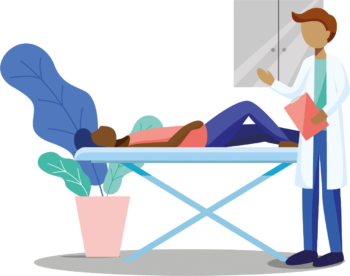
ACA member Jennifer Gantzer, DC, MS, DACBN, FACN, is both a chiropractor and a board-certified clinical nutritionist. She is an educator at her alma mater, National University of Health Sciences in Pinellas Park, Fla., and provides care at the university’s clinic. Pain management and injury recovery are personal to Dr. Gantzer; after a serious accident, she experienced firsthand the benefits of chiropractic’s patient-centered, whole-person approach to pain management, musculoskeletal and spinal rehabilitation, as well as health and wellness techniques. With time, patience, and an integrative approach to treatment, she has come a significant way in her recovery. Her healing process continues to this day, and nutrition and lifestyle choices along with chiropractic care continue to play an important role in keeping her body moving and pain free.
Hands Down Better learns more about Dr. Gantzer’s health journey below:
Tell us about your accident and how your body was affected?
Dr. Gantzer: Six years ago, I was struck by a drunk driver crossing the street as a pedestrian, which put me in the ICU for five days. My injuries included a fractured right pelvis, reduced use of my right shoulder and arm, a blown right ear drum and a fracture to my left eye socket, as well as significant bruising and swelling on both legs and deep ulcerations in several places on my legs and arms. Additionally, I suffered a concussion and had to withdraw from my nutrition master’s program for one year. As a solo practitioner, I had to close my practice and go on medical leave.
Utilizing all combinations of the treatments I perform in practice, within months I gained a significant return to activities of daily living, was off crutches and had relearned to walk without a limp, being very mindful of not over-doing it nor carrying anything heavy or off-centered.
My first two weeks involved acute care with cold laser, ultrasound, microcurrent, and PEMF (pulsed electromagnetic frequency) for pain and regenerative healing, higher doses of daily anti-inflammatories without narcotics, plus simple stretching (which initially required help to perform), and special taping (Rocktape/KT Tape) for improving the rate of bruising and pain from joint strain.
Interestingly, near 90 days or so I could ride my bike without pain, unlike walking which was still quite slow and challenging. And, even more amazing, when I began to experience stiffness and numbness —and emotional frustration — simply jumping on the bike and riding in the fresh air with my headphones and a brainwave app was cathartic and pain-relieving. Recovery involves pain management as well as mental and cognitive healing. Mindful meditation and reflective forgiveness and acceptance were, and still are, a huge part of the successful full recovery I’ve experienced.
What role did chiropractic care play in the recovery of your injuries?
Dr. Gantzer: I must first make the disclaimer that chiropractic care is more than spinal adjustments. It involves, as part of our educational curriculum, being trained and certified in physical therapy and musculoskeletal rehab, which includes joint manipulation of the spine and extremities (shoulder, elbow wrist, fingers, hip, knee, ankle, toes) as well as training in the use of physical modalities [devices] such as laser and infrared light therapies, ultrasound and microcurrent, which each in their own way support pain management but also the repair and regeneration phase of healing. PEMF, for example, supports healing and regeneration by improving microcirculation, aiding in delivery of nutrients to tissues.
Chiropractors may also use electric stim, which many people know as a “TENS unit.” There are other professional in-office options for pain management that may be less effective for tissue regeneration, which is an important reason to clinically combine them with therapies that promote regeneration.
(Editor’s Note: It’s important to understand that chiropractors in the U.S. are licensed by the states, and their scope of practice and the type of therapies they can provide may be different depending on where they practice. Learn more here.)
In my case, I started with chiropractic care on day three while I was still in the ICU. The hospital allowed me to use my professional cold laser device, and even though I couldn’t move my legs actively, I had the nurses stretch me every day. I was discharged on a Wednesday and that following Monday I called my chiropractor. After an exam, history, a review of my hospital images, and diagnosis, I was adjusted, with mindful care to the pelvic region and excluding extremities due to the bruises and abrasions. I continued to be adjusted several days a week for the first several months. I also did rehab every day, including anti-inflammatory, pain relief, and regenerative combinations that I credit for the speed at which I healed. I was able to progress in a short time out of acute pain and off crutches into fairly full recovery. It’s an ongoing process.
Chiropractors focus on lifestyle factors, as well. Why?
Dr. Gantzer: Pain is not only physical. In lifestyle medicine, and evidence-based models, there is a clinical correlation of enhanced improvements when the pain and regenerative process is supported with mental health and modifiable lifestyle changes that focus on things like sleep and digestion, overall nutritional status, inflammation in the body, stress management, social relationships, and self-care.
What is the connection between inflammation, pain and nutrition, and how might a nutritionist like you address it in support of a patient’s recovery?
Dr. Gantzer: Perceived pain, nutritional status, and the underlying inflammatory state of the body are intimately related, as well as the ability to heal, repair and regenerate, which coincides with pain management. A malnourished, chronically inflamed body lacks the tools to heal, and underlying excessive inflammation — whether from new or old injuries, metabolic distress, or malnutrition — is a source of increased pain potential.
We should consider the value of using natural anti-inflammatories including turmeric, curcumin, ginger, Boswellia, and flavonoids, which act in a similar manner as over-the-counter Ibuprofen and other non-steroidal anti-inflammatory drugs (NSAIDS), but without many of the adverse side effects such as GI distress (known to be associated with NSAIDs, especially higher daily doses), and aren’t addictive like opioids.
For chronic pain and supporting the healing process it’s vital to include the essential nutrients, those that the body requires but cannot make on its own: minerals, water-soluble B-vitamins plus Vitamin-C, fat-soluble vitamins A, E, D, K and the anti-inflammatory essential fatty acid that is from fish oil, flax and seaweeds. Each serves unique functions and is why a quality multivitamin with a fish oil supplement is commonly recommended by nutritionists alongside whole foods that deliver them too. Additionally, most people are deficient in Vitamin D and need a higher therapeutic dose short term. Vitamin D has far-reaching benefits for pain and immune support well beyond its known effect for calcium and bone.
They also might address weight and BMI, support digestion, try to improve sleep, and clean up low-grade infections. When the whole body is addressed for imbalance, there is an overall beneficial effect; balancing the whole body promotes less pain and degeneration, and better healing.
The importance of a whole-food diet with nutrient dense choices can’t be expressed enough. The combination of diet, supplements, and modifiable habits should not only be part of a treatment regime for pain, injury, and recovery, but should also be an integral component of everyone’s overall lifestyle.
An excellent example would be following a low carb, modified fiber-rich ketogenic, mixed Mediterranean dietary lifestyle. These foods deliver maximal nutrients and antioxidants, while also being anti-inflammatory. The Western diet — with its processed foods, large portions and high levels of Omega-6 oils (correlated with obesity, insulin resistance and metabolic syndrome) are large drivers of pain and poor recovery.
If there is one single tip I can give to someone who is striving to shift their eating in a better direction, it is to be conscious of carbs and sugars and the amount of refined processed foods (e.g., boxed, bagged, baked, and sweetened); start by removing those, while slowly trying to add in more whole-food fresh items This small change can have a powerful impact on the body’s inflammatory status, which is a big driver of pain.
Based on your experience, what else is helpful for people recovering from pain to understand?
Dr. Gantzer: Poor stress management and negative thought processes have potent effects on the neuroinflammatory pathways, with downstream effects on blood pressure, digestion, weight, sleep and social behaviors. Self-care and working through negative emotions play important roles in pain modulation and improved quality of life. Lastly, it’s important to have a realistic approach to addressing chronic pain. Along with improvements, we should anticipate relapses and flares during the healing process. I know this from clinical experience, but also as a managed permanent injury patient. I’m grateful for all the wonderful chiropractic care I’ve received and continue to receive, as well as my education and experience, which guides my dietary lifestyle and supplemental choices day to day, granting me a majority of pain-free and pain-low days.
Reviewed by the ACA Editorial Advisory Board. The information in this post is for educational purposes. It is not a replacement for treatment or consultation with a healthcare professional. If you have specific questions, contact your doctor of chiropractic. To find an ACA chiropractor near you, click here.



